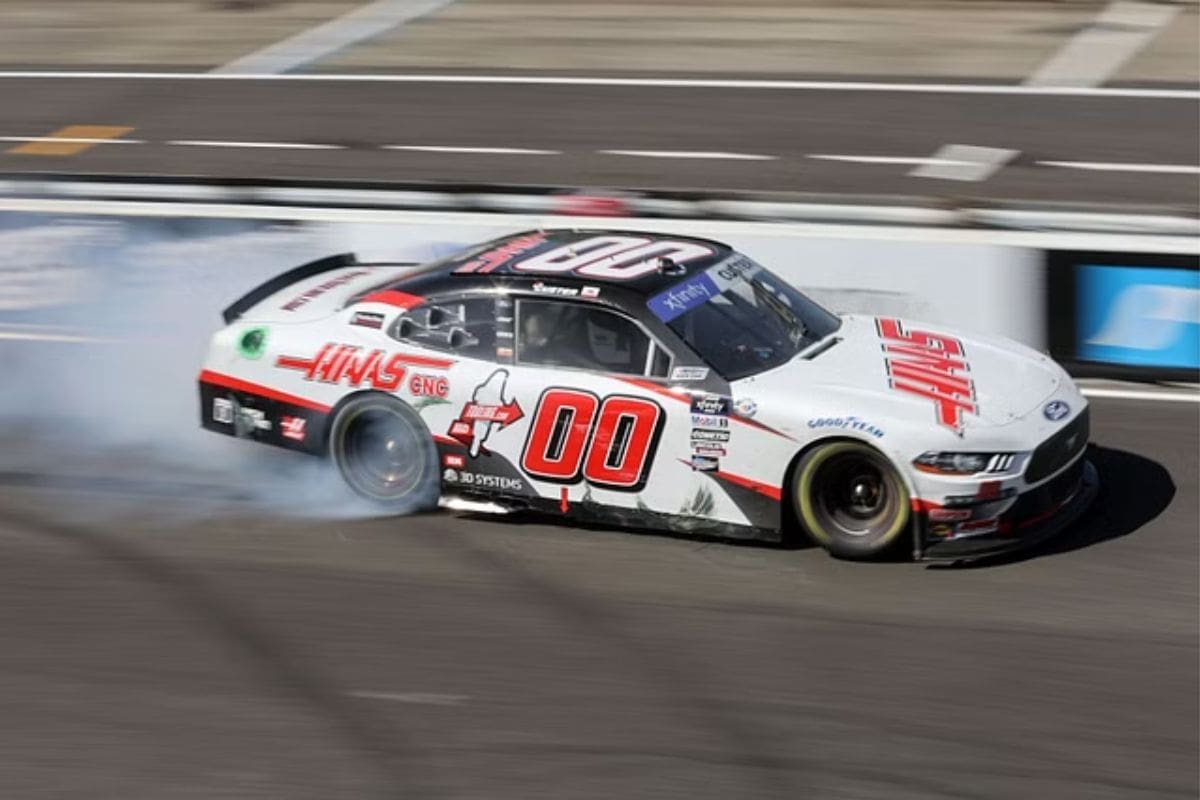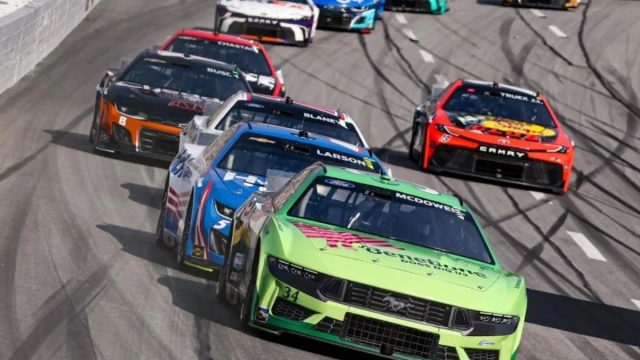Freddie Kraft Admits Mistake: Freddie Kraft’s recent admission of error following a lackluster performance at the Enjoy Illinois 300 race emphasizes the crucial role spotters play in NASCAR. The intricacies of the World Wide Technology Raceway’s visibility issues were evidently a significant factor, challenging Kraft’s ability to deliver precise guidance to Bubba Wallace. As Kraft owns up to his oversight, it raises intriguing questions about how he plans to adapt and refine his strategies for the upcoming Sonoma Raceway event. This acknowledgment not only highlights the importance of the sport but also sets the stage for a potential redemption arc, demanding a closer examination of his approach moving forward.
Key Highlights
- Freddie Kraft acknowledged visibility challenges and mistakes during Enjoy Illinois 300.
- Kraft admitted the difficult track configuration and elevation changes affected his spotting.
- Environmental conditions further complicated Kraft’s ability to provide accurate information.
- Kraft emphasized the importance of learning from these mistakes for future races.
- He stressed the need for improved strategies and better preparedness for upcoming events like Sonoma.
The Role of Spotters in NASCAR
In NASCAR racing, spotters play a crucial role by providing drivers with crucial real-time information that compensates for their limited field of vision. NASCAR drivers, constrained by the design of their vehicles and the nature of the sport, experience a kind of tunnel vision, primarily focusing on what lies directly ahead. This limited perspective necessitates the presence of spotters, who function as the drivers’ eyes, offering them critical updates throughout the race.
A spotter’s duties encompass a range of important tasks, including informing drivers about the positions of rival cars, alerting them to on-track incidents, and advising on the best racing lines. Positioned high above the track, spotters enjoy an unobstructed view, enabling them to relay detailed situational awareness. Such guidance is crucial when drivers execute skills like overtaking or defending their position, where split-second decisions can drastically alter race outcomes.
Moreover, spotters provide emotional and strategic support, acting as a calming influence during high-pressure moments. Their communications help drivers maintain focus and composure, mitigating the risk of errors induced by stress and fatigue. This symbiotic relationship between driver and spotter is built on trust and precision, with the latter’s input often determining the success or failure of race strategies.
The integral role of spotters cannot be overstated, as they contribute significantly to the safety and competitive edge of the drivers. Their real-time insights not only improve performance but also ensure the smooth execution of race tactics, highlighting their importance in the intricate and demanding world of NASCAR racing.

Challenges Faced by Spotters
Spotters, despite their pivotal role, face significant challenges that can complicate their ability to provide accurate and timely information to drivers. One of the primary difficulties lies in maintaining clear visibility and distinguishing between cars on the track. With numerous vehicles moving at high speeds, even the slightest obstruction or similarity in car designs can lead to confusion and miscommunication.
The responsibility placed on spotters is immense; they must relay important information about upcoming turns, potential hazards, and the positions of competing cars. The raised stands where spotters are stationed offer an advantageous vantage point, yet this does not always guarantee a perfect view.
For instance, at the Gateway track, spotter Freddie Kraft encountered complications that contributed to a disappointing race for Bubba Wallace. The similarity in car appearances compounded the difficulty of providing precise guidance, highlighting the inherent challenge of visual identification in a dynamic racing environment.
Additionally, the auditory environment can be equally demanding. The roar of engines, combined with radio communications from multiple teams, can create a cacophony that makes it difficult for spotters to communicate effectively with their drivers. This auditory overload can lead to critical information being missed or misunderstood, affecting race strategy and safety.
“I sounded like an idiot.” – (Kraft)
“I promise you, I wasn’t hungover from the bachelor party, I didn’t have a sip of alcohol all weekend.” – (Kraft)
Spotters must also contend with environmental conditions such as changing light and weather. Glare from the sun, rain, or even dust can obscure vision and further complicate their task. These factors necessitate exceptional focus and adaptability, as spotters must continuously adjust to the evolving conditions to provide accurate and actionable information.
World Wide Raceway Track Visibility Issues
The Gateway track presents unique visibility challenges that greatly hinder spotters’ ability to provide accurate and timely guidance to drivers. Freddie Kraft, an experienced spotter for Bubba Wallace, openly admitted that the recent race at Gateway was among his most challenging, highlighting the inherent difficulties posed by the track’s layout and infrastructure.
In turn one is you lose kind of sight of your car. It’s just you’re looking at tail panels and all that. I mean, I felt like yesterday all of them were black and they drive down into one and they start splitting each other and you can’t see the runs coming because they’re driving straight away from you. And you can’t see who’s got momentum and you can’t see who’s kind of getting ready to peak out.” – (Kraft)
- Track Configuration: The unique oval shape of the Gateway track with its varying banking angles and tight corners makes it extremely difficult for spotters to maintain a clear line of sight on their drivers throughout the race. The shifts from one part of the track to another can cause blind spots, complicating real-time communication.
- Elevation Changes: Unlike some flatter tracks, Gateway features subtle changes in elevation that can obscure a spotter’s view. This topography can result in brief moments where the car is not visible, leading to a potential delay in critical information being relayed to the driver.
- Infrastructure Limitations: The location and height of the spotter stands at Gateway may not be ideal, which can limit the field of vision. Spotters often have to work around these constraints, which can further heighten the challenge of providing precise and timely guidance.
- Weather Conditions: External factors such as glare from the sun, rain, or fog can impair visibility to a great extent. Even though these conditions are not unique to Gateway, the combination with the track’s inherent visibility issues makes it a particularly tough environment for spotters.

Challenges at Sonoma Raceway
Mastering the intricacies of Sonoma Raceway poses a formidable challenge for spotters, who must grapple with the track’s elaborate layout and numerous elevation changes to provide accurate and timely guidance to their drivers. Unlike the relatively straightforward nature of oval tracks, Sonoma’s road course layout features 12 distinctive turns, each presenting its unique set of difficulties. The complexity of these turns demands that spotters maintain acute situational awareness and precise communication to make certain that drivers navigate the course efficiently and safely.
The track’s elevation changes further complicate the spotter’s job. Rapid ascents and descents can obscure visibility, making it challenging to relay critical information about competitors’ positions and track conditions. Spotters must continuously adapt their perspectives and anticipate the drivers’ needs, often requiring swift judgment and impeccable timing. The necessity for spotters to be physically mobile, often switching vantage points, highlights the dynamic nature of their role at Sonoma.
Turn 11, notoriously known as the most dreaded corner on the track, exemplifies the challenges at Sonoma Raceway. This hairpin turn requires drivers to decelerate sharply, making it a hotspot for overtaking actions and potential collisions. For spotters, this means carefully monitoring the sequence of cars, communicating braking points, and alerting drivers to any sudden changes in traffic patterns. The urgency to provide flawless guidance is immense, as any miscommunication can lead to catastrophic results.
Redemption at Sonoma Raceway
Freddie Kraft views the upcoming race at Sonoma Raceway as an important moment to demonstrate his capability for precise and effective spotting, especially after the setbacks encountered at Gateway. The winding configuration of Sonoma’s road course presents a unique set of challenges, demanding a meticulous approach and a steadfast focus. For Kraft, the race is an opportunity to apply the lessons learned from the Gateway debacle and to make sure that Bubba Wallace navigates the tricky track efficiently.
- Improved Communication: Building on the communication flaws exposed at Gateway, Kraft has prioritized clearer and more consistent dialogue with Wallace to anticipate any misunderstandings during the race.
- Thorough Track Analysis: Kraft has looked into a detailed study of Sonoma’s layout, identifying critical sections where precise spotting can have a substantial impact on Wallace’s lap times and race positioning.
- Simulation Training: Both Kraft and Wallace have intensified their use of simulators to practice potential scenarios, fine-tuning their strategies to tackle the different elevations and tight corners characteristic of Sonoma.
- Collaborative Strategy Sessions: Kraft has scheduled additional strategy meetings with the entire team, ensuring that every member is aligned and prepared for the specific demands of Sonoma’s course.

News in Brief: Freddie Kraft Admits Mistake
The acknowledgment by Kraft of the error at Gateway emphasizes the crucial role of spotters in NASCAR, where visibility challenges can greatly impact race outcomes. Addressing these challenges, particularly at tracks like Sonoma Raceway, will be vital for future success.
This incident highlights the importance of continual learning and improvement in high-stakes environments. The upcoming race at Sonoma provides an opportunity for redemption, emphasizing the dynamic nature of team coordination and strategic adaptation in motorsports.
Also Read: Freddie Kraft Criticizes NASCAR’s Uncertainty With Kyle Larson
